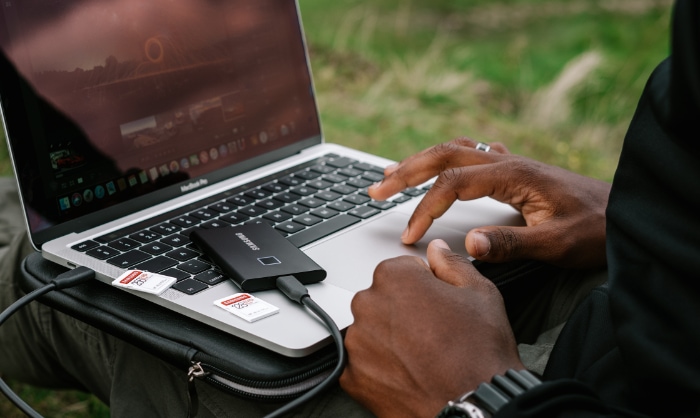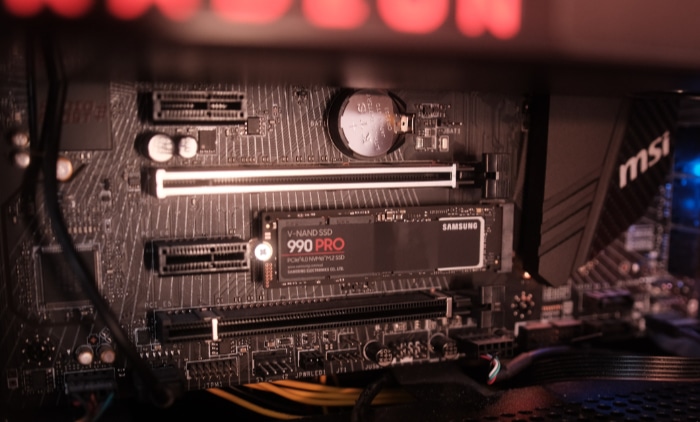SSD Keeps Disconnecting: Causes and Fixes

In our digitized era, reliable data storage is more than just a convenience—it’s an absolute necessity. One common storage solution is the Solid State Drive (SSD), known for its speed and durability.
However, as with any technology, SSDs can encounter problems. One particularly frustrating issue for users is when an SSD—whether internal or external—keeps disconnecting, disrupting the flow of work or even risking data loss.
The purpose of this blog post is to dig into this issue, highlighting the common symptoms of SSD disconnection and exploring potential reasons behind the problem. We will also provide practical troubleshooting steps and preventive measures to ensure optimal SSD performance.
Common Symptoms of SSD Disconnection
Before we investigate the technicalities of the SSD disconnection issue, it’s crucial to understand its symptoms. Recognizing these early warning signs can help you take timely action and prevent potential data loss.
Sudden System Freezes or Crashes
One of the most common symptoms of an SSD disconnection is a sudden and unexplained system freeze or crash. This can happen while you’re in the middle of a task, causing your computer to become unresponsive. This symptom is often a sign that the computer is having trouble accessing the SSD, and hence, the data it needs for its operations.
Disappearing Files or Folders
Another symptom that might raise red flags is when files or folders that you know should be on the SSD suddenly go missing. You may also find that certain files or applications take an unusually long time to load, or they might not load at all. This could indicate that the SSD is intermittently disconnecting, making the files inaccessible at times.
Computer Failing to Recognize the SSD
Perhaps the most direct sign of SSD disconnection is when your computer fails to recognize the SSD entirely. This could manifest as the SSD not appearing in the list of drives, or a notification appearing stating that the device can’t be read.
In the case of external SSDs, they might not show up after being plugged in, or they might suddenly disappear while in use.
It’s essential to take these symptoms seriously, as they can suggest a looming SSD failure. Early detection and intervention can help prevent data loss and prolong the life of your SSD.
Potential Reasons for SSD Disconnection
Once you’ve identified the symptoms of an SSD disconnection, understanding the root causes of the problem is the next step. These reasons can vary widely, from physical issues like overheating or loose connections to software-related problems such as outdated drivers. In this section, we’ll examine these potential causes in more detail.
Overheating of the SSD Drive
Excessive heat can negatively impact the performance of your SSD, leading to disconnections. This is particularly true for internal SSDs, which are more prone to heat buildup due to their proximity to other components. Poor ventilation or a malfunctioning fan can exacerbate this problem, causing the SSD to overheat and disconnect to protect itself from damage.
Loose or Faulty Connections
For both internal and external SSDs, a loose or faulty connection can lead to intermittent or continuous disconnection. In the case of internal SSDs, this could be due to a loose cable inside the computer. With external SSDs, it could be an issue with the USB port or the cable connecting the SSD to the computer.
Outdated SSD Firmware or Driver
Firmware and drivers are essential for your computer to properly communicate with your SSD. If these are outdated, it can lead to miscommunication, causing the SSD to disconnect. Regularly updating your firmware and drivers can help avoid this issue.
Power Supply Issues
Inadequate power can cause your SSD to disconnect. This could be due to a power supply unit (PSU) that’s failing or not powerful enough to handle all the components of your computer. For external SSDs, improper ejection can also lead to power-related disconnections.
Incorrect BIOS Settings
The Basic Input/Output System (BIOS) is responsible for the initial hardware checks when your computer is started. Incorrect settings here can cause the system to fail to recognize the SSD, leading to disconnection issues.
SSD Drive Reaching its Lifespan
All SSDs have a finite lifespan, determined by the number of write cycles they can handle. As an SSD approaches this limit, it may start to fail, leading to disconnection issues. Monitoring the health of your SSD can help you anticipate and prepare for its end of life.
Troubleshooting SSD Disconnection

Experiencing an SSD disconnection can be frustrating, but there are several troubleshooting steps you can take to resolve the issue. From checking physical connections to updating software, these methods can help restore your SSD’s functionality and protect your data. Let’s walk through these troubleshooting steps.
Checking and Securing Physical Connections
The first step in troubleshooting any SSD disconnection issue is to check the physical connections. For an internal SSD, this would mean opening your computer case and ensuring the SSD is properly connected to the motherboard and power supply.
For an external SSD, you should check both ends of the cable to ensure they are securely connected to the SSD and the computer. Using a different USB port or a new cable may also help identify if the issue lies in these areas.
Updating SSD Firmware and Drivers
Keeping your SSD firmware and drivers up to date is essential for its smooth operation. Check the manufacturer’s website for the latest updates and follow their guidelines for installation. This can often solve communication issues between your computer and the SSD.
Checking and Adjusting Power Settings
In some cases, power settings in your operating system could cause your SSD to disconnect. For instance, Windows has power-saving settings that can turn off hard drives after a period of inactivity. Ensure these settings are configured correctly to prevent unintended disconnections.
Adjusting BIOS Settings for Internal SSDs
If you’re using an internal SSD and it keeps disconnecting, you might need to check your BIOS settings. Make sure your SSD is recognized and properly configured. Consult your motherboard’s manual or the manufacturer’s website for detailed instructions.
Using Software Tools to Check SSD Health
Several software tools can provide information about the health of your SSD, including its temperature, the number of write cycles it has been through, and any potential errors. Examples of these tools include CrystalDiskInfo and SSD Life. Regularly monitoring the health of your SSD can help you anticipate and mitigate potential disconnection issues.
Preventing Future SSD Disconnections
Prevention is always better than cure. After troubleshooting your SSD disconnection issue, it’s important to take proactive measures to prevent such problems in the future. This involves regular maintenance, safe handling practices, and diligent data management. Let’s discuss these preventive measures in more detail.
Routine SSD Health Checks
Make a habit of regularly checking your SSD’s health using software tools. This can help you spot potential issues before they cause disconnection problems, and allow you to replace or repair your SSD in a timely manner.
Maintaining Optimal Operating Conditions
Ensure your computer is kept in a clean, dust-free environment with good ventilation. Excessive heat and dust can damage electronic components and lead to SSD failures. Regular cleaning and maintenance of your system can go a long way in preventing SSD disconnections.
Using High-Quality Equipment
For external SSDs, invest in high-quality cables and ensure that the USB ports you use are in good working condition. Cheap or faulty equipment can lead to intermittent disconnections and data loss.
Safe SSD Handling Practices
Always handle SSDs—whether internal or external—with care. This is especially crucial when you’re installing or moving them. Mishandling can damage the SSD and cause it to disconnect or fail.
Scheduled Backups
Set up a schedule for backing up your data regularly. This won’t necessarily prevent SSD disconnections, but it will safeguard your data in case of an SSD failure. Having a solid backup strategy can save you a lot of trouble and data loss.
Conclusion
SSDs disconnection can be more than an inconvenience—it can disrupt workflows and risk crucial data loss. However, by staying vigilant for common symptoms such as system crashes, missing files, or the computer failing to recognize the SSD, you can catch and address issues early on.
Potential reasons for SSD disconnection, such as overheating, loose connections, outdated firmware or drivers, power supply issues, incorrect BIOS settings, or the SSD reaching its lifespan, require different approaches for resolution. Troubleshooting these problems may involve checking physical connections, updating software, adjusting power and BIOS settings, or even employing software tools to monitor SSD health.
Moreover, prevention is always better than cure. Regular SSD health checks, maintaining optimal operating conditions, using high-quality equipment, practicing safe SSD handling, and scheduling routine backups can help prevent future SSD disconnections and ensure the longevity of your SSD.
By following these guidelines, you can effectively manage your SSD, ensuring smooth performance and safeguarding your data. Remember, the key to maintaining your SSD’s health lies in regular monitoring and proactive intervention.


